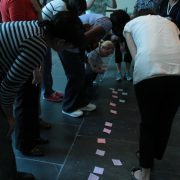By Ed Liskey, Senior Scheduling & Exhibitor Relations Coordinator, Smithsonian Institution Traveling Exhibition Service
We’d like to share some of the great experiences Affiliate museums have had hosting SITES exhibitions this past summer. When will you get your SITES on?

Native Words, Native Warriors at the Wisconsin Maritime Museum
The Wisconsin Maritime Museum (Manitowoc, WI) is hosting SITES’ Native Words, Native Warriors, from July 23- October 2, 2011. It’s the remarkable story of Indian soldiers from more than a dozen tribes who used their Native languages in the service of the U.S. military.
Museum Educator Wendy Lutzke reports that the museum has made interesting historical connections between the exhibition and its World War II submarine, the USS Cobia. The Cobia is the largest artifact in the museum’s collection, and is moored right outside the gallery. “While researching the history of the Code Talkers in the Pacific, intern Nick Oswald found that both the Code Talkers and the crew of the USS Cobia had a direct impact on the outcome of the battle of Iwo Jima. Code Talkers revealed deceptive Japanese communications that mimicked those sent by the Allies, while the crew of the USS Cobia destroyed two Japanese vessels, one of which was carrying tanks intended for Iwo Jima.”

Native Words, Native Warriors at the Wisconsin Maritime Museum
In September, the museum will feature Oneida Nation historian Loretta Metoxen, to speak on the Oneida’s contribution to the Code Talker Program. A medal recognizing the Oneida individuals involved in the program will be struck by the U.S. Mint later this fall.
The Charlotte Museum of History (Charlotte, NC) hosted SITES’ Becoming American: Teenagers & Immigration exhibition April 23 – July 17, 2011, and visitors loved every minute of it. Photographer Barbara Beirne’s images capture first-generation immigrants and children of immigrants, revealing a diverse array of teenage responses to the immigrant experience.

Becoming American installation at The Charlotte Museum of History
Exhibits Manager Lee Goodan reported that “the Museum actively works to engage the diverse community of the Charlotte/Mecklenburg region, home to many immigrants from other areas of the world and transplants from around the country. The stories of Becoming American reflect the diverse make-up of the area, and provide compelling examples of finding identity with migration. As we explore the theme of home within our institution, this exhibition illustrated the challenges and opportunities of finding and remembering ‘home.’ The focus on teenagers provided us the opportunity to create a successful program for high school students. Based on visitor feedback, the content resonated with our visitors who identified with the stories or found the exhibition insightful on a topic with which they were not personally familiar.”

Becoming American high school program at The Charlotte Museum of History
Ms. Goodan continued: “It was an excellent exhibition- compelling, thought-provoking, and directly presented. The primary strength of the exhibition was that it seemed to be very effective at evoking responses- either intellectual or emotional- from visitors. Based on comments left in the exhibition response book, we received more comments of a personal or substantive nature than usual. Some included political or social commentary, some shared personal experience with immigration, and some simply noted that they had been touched or affected by the stories.”

Farmers, Warriors, Builders a the South Florida Museum
The South Florida Museum and Parker Manatee Aquarium (Bradenton, FL) is currently hosting Farmers, Warriors, Builders: The Hidden Life of Ants, on view through October 9, 2011. More than 140 guests got buggy with entomology family fun on Saturday, August 6 at a “Family Night” program at the museum. Hands-on crafts, a cartoon movie about the critters, and a scavenger hunt through the museum including the Farmers, Warriors, Builders exhibition all made the event a huge hit.
The museum team is thrilled about another exhibition-related event with Dr. Mark Moffett, the world-renowned ant expert, award-winning photographer, and Smithsonian Research Associate whose work is featured in the exhibition. On September 29, he will present “Adventures Among Ants: A Global Safari with a Cast of Trillions” based on his newest book of the same title. “We are thrilled to bring such a witty, experienced, renowned scientist and real-life adventurer to our community,” said Brynne Anne Besio, Executive Director. “This fascinating exhibition and the chance to meet Dr. Moffett represent such a unique opportunity for our members and the general public to learn from a modern-day explorer.”
Please visit our website to learn more about all of our exhibitions that will help you get your SITES on.

The Affiliate flag in the Becoming American installation at the Charlotte Museum of History




















